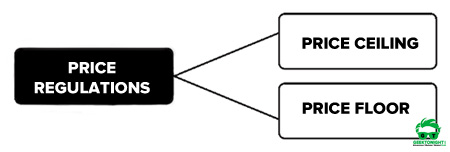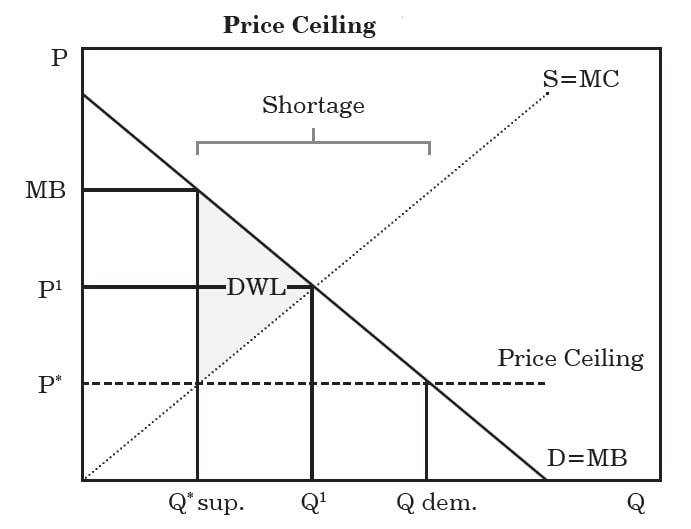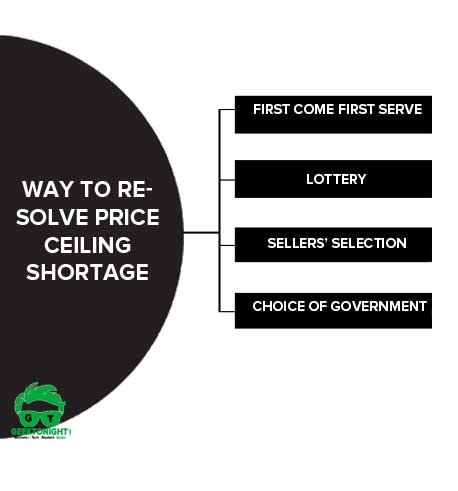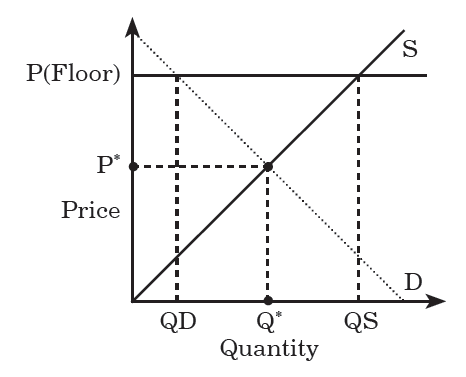Price regulations are governmental measures dictating the quantities of a commodity to be sold at a specified price both in the retail marketplace and at other stages in the production process.
These regulations act as control measures or emergency economic measures in the case of imperfect competition to prevent probable market failures.
Table of Content [Show]
Price Regulations Example
For example, in monopolies, sellers have complete market power of controlling the pricing decisions and setting prices higher than in competitive markets. In such a case, demand for the product does not lower down, which can lead to market failure.
Thus, the government is required to intervene in the scenario to prevent market failures. By using price regulations, the government not only controls the functioning of the market, rather protects consumer welfare.
There are various price mechanism used by the government to regulate the prices in the market. The most commonly used price regulations are Price Ceiling and Price Floor.

What is Price Ceiling?
A price ceiling can be defined as the price that has been set by the government below the equilibrium price and cannot be soared up above that.
Price Ceiling Example
For example, price ceiling occurs in rent controls in many cities, where the rent is decided by the governmental agencies. The rent is allowed to rise at a specific rate each year to keep up with inflation. However, the rent must remain below equilibrium.
It is observed that a shortage occurs by setting price ceiling. This is due to more demand than there is at the equilibrium price at which the price of the ceiling is defined.
Moreover, supply is also reduced than the supply at the equilibrium price. This results in increased demand of the commodity than the quantity supplied. Consequently, marginal costs are exceeded by marginal benefits resulting in inefficiencies equivalent to the deadweight welfare loss.

Price Ceiling Shortage
The shortages created by price ceilings can be resolved in many ways without increasing the price. Following are the ways that can be used to resolve shortages:
Way to Resolve Price Ceiling Shortage

First come first serve
This is the most common way of resolving the shortage, wherein, the person who comes first gets to buy the product.
A common example of this is the people standing in line at the counter of a cinema hall to buy the tickets to a movie.
Lottery
It is a type of lucky draw, where one lucky person who picks the right numbers is allowed to make the purchase. The lottery system is could be a way to dole out a product that is facing a shortage.
For example, some chargers may use this system to determine the persons who could buy the limited tickets to a special game of football.
Sellers’ selection
Another way of resolving the shortage due to price ceiling is allowing sellers to select the buyers to whom they want to sell their products.
For example, many landlords select renters to rent based on certain criteria (such as preference for the married couple and without pets).
Choice of government
On many occasions it is left to the government to make the selection of buyers.
For example, to deal with the shortage of gasoline in 1979, the California government allowed the sale of gasoline to those who had license plates of their vehicles ending in an odd number on the odd days of the month.
What is Price Floor?
A price floor is said to exist when the price is set above the equilibrium price and is not allowed to fall. It is used by the government to prevent the prices from hitting a bottom low.
Price Floor Example
The most common example of a price floor is the setting of minimum daily wages of a labour worker, where the minimum price that can be paid to labour is established. This is mostly done to protect the farmers.

A predominant condition for price floor to be effective is to place the price floor above the equilibrium price. If the price is not set above equilibrium, the market does not sell below the equilibrium price and the price floor will become inappropriate.
Way to Resolve Price Floor Shortage
There are some problems due to the surplus (quantity in demand is lesser than the quantity in supply) created through the price floor. If the surplus exists in the market for a long period, the price floor begins to fall below the price of equilibrium, which can result in market failure. Thus, the government is required to intervene to avoid the occurrence of surplus. Some of the measures that can be adopted by the government to deal with the surplus are:
- Purchase of all surplus goods: A way to deal with the surplus is the purchase of all the surplus goods by the government. The surplus can be sold to other countries. For example, the US government had bought all the surplus grain in the US and sold it to Africa.
- Control of production by the government: Another way to control the surplus is the government’s control over the production. The government can offer rights of production to some of the selected suppliers. If the government gives out the rights for production to some suppliers (selected on a specific criterion) or compensates them for not making any additional supply, then the unnecessary production of goods can be eliminated.
- Sponsorship of consumption: The government can also sponsor the buyers by paying a part of the cost. This would help the buyers to buy more of the surplus
Leave a Reply